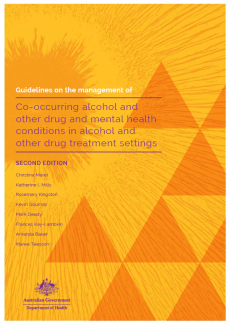Guidelines on the Management of Co-Occurring Alcohol and Other Drug and Mental Health Conditions in Alcohol and Other Drug Treatment Settings

In a nutshell...
These Guidelines aim to provide alcohol and other drug (AOD) workers with evidence-based information to assist with the management of co-occurring, or comorbid, AOD and mental health conditions. They represent an update and revision of the first edition of these Guidelines published in 2009.
Population estimates indicate that more than one-third of individuals with an AOD use disorder have at least one comorbid mental health disorder; however, the rate is even higher among those in AOD treatment programs. Additionally, there are a large number of people who present to AOD treatment who display symptoms of disorders while not meeting criteria for a diagnosis of a disorder.
The high prevalence of comorbidity means that AOD workers are frequently faced with the need to manage complex psychiatric symptoms that may interfere with their ability to treat clients’ AOD use. Furthermore, clients with comorbid mental health conditions often have a variety of other medical, family, and social problems (e.g., housing, employment, welfare, legal problems). As such, it is important that AOD workers adopt a holistic approach to the management and treatment of comorbidity that is based on treating the person, not the illness (see Chapter B1).
The first step in responding to comorbidity is being able to identify the person’s needs (see Chapters B2 and B3). Despite high rates of comorbidity among clients of AOD services, it is not unusual for comorbid mental health conditions to go unnoticed. This is mostly because AOD workers are not routinely looking for them. It is a recommendation of these Guidelines that all clients of AOD treatment services should be screened and assessed for comorbidity as part of routine clinical care.
Once identified, symptoms of mental health conditions may be effectively managed while the person is undergoing AOD treatment (see Chapters B5 and B6). The goal of management is to allow AOD treatment to continue without mental health symptoms disrupting the treatment process, and to retain clients in treatment who might otherwise discontinue such treatment. Comorbidity is not an insurmountable barrier to treating people with AOD use disorders. Indeed, research has shown that clients with comorbid mental health conditions can benefit just as much as those without comorbid conditions from usual AOD treatment.
Some clients with comorbidity may require additional treatment for their mental health problems (see Chapter B6). Some interventions have been designed for the treatment of specific comorbidities; however, these interventions generally have not been well researched. Where there is an absence of specific research on comorbid disorders, it is recommended that best practice is to use the most effective treatments for each disorder. Both psychosocial and pharmacological interventions have been found to have some benefit in the treatment of many comorbidities. Consideration should also be given to the use of e-health interventions, physical activity, and complementary and alternative therapies, as an adjunct to traditional treatments.
In addition to mental health services, AOD workers may need to engage with a range of other services to meet clients’ needs, including housing, employment, education, training, community, justice, and other support services. A broad, multifaceted, and co-ordinated approach is needed in order to address all of these issues effectively, and it is important that AOD services and workers develop links with a range of local services (see Chapter B4).
